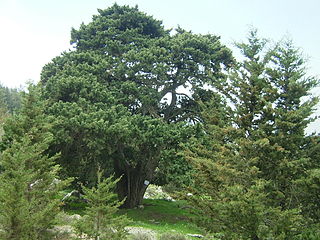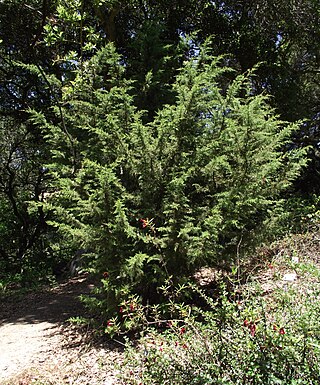Cypress is a common name for various coniferous trees or shrubs of northern temperate regions that belong to the family Cupressaceae. The word cypress is derived from Old French cipres, which was imported from Latin cypressus, the latinisation of the Greek κυπάρισσος (kyparissos). Cypress trees are a large classification of conifers, encompassing the trees and shrubs from the cypress family (Cupressaceae) and many others with the word “cypress” in their common name. Many cypress trees have needle-like, evergreen foliage and acorn-like seed cones.

Cupressus is one of several genera of evergreen conifers within the family Cupressaceae that have the common name cypress; for the others, see cypress. It is considered a polyphyletic group. Based on genetic and morphological analysis, the genus Cupressus is found in the subfamily Cupressoideae. The common name "cypress" comes via the Old French cipres from the Latin cyparissus, which is the latinisation of the Greek κυπάρισσος (kypárissos).

Hesperocyparis macrocarpa is a coniferous tree. It is commonly known as the Monterey cypress and is one of several species of cypress trees endemic to California.

The Leyland cypress, Cupressus × leylandii, often referred to simply as leylandii, is a fast-growing coniferous evergreen tree much used in horticulture, primarily for hedges and screens. Even on sites of relatively poor culture, plants have been known to grow to heights of 15 metres (49 ft) in 16 years. Their rapid, thick growth means they are sometimes used to achieve privacy, but such use can result in disputes with neighbours whose own property becomes overshadowed. The tree is a hybrid of Monterey cypress and Nootka cypress. It is almost always sterile, and is propagated mainly by cuttings.

Xanthocyparis is a genus of cypresses in the family Cupressaceae. As of August 2021, it has only one species, Xanthocyparis vietnamensis, native to Vietnam and southeast China. It is commonly known as the Vietnamese golden cypress. The Nootka cypress, Cupressus nootkatensis or Callitropsis nootkatensis, was also placed in the genus, but this has been rejected.

Cupressus goveniana, now reclassified as Hesperocyparis goveniana, with the common names Californian cypress and Gowen cypress, is a species of cypress, that is endemic to California.

Cupressus pigmaea, the Mendocino cypress or pygmy cypress, is a taxon of disputed status in the genus Cupressus endemic to certain coastal terraces and coastal mountain ranges of Mendocino and Sonoma Counties in northwestern California. It is a highly variable tree, and closely related to Cupressus goveniana, enough to sometimes be considered a subspecies of it.
Macrocarpa, large-fruited in Latin, may refer to:

Peavy Arboretum is an arboretum operated by Oregon State University and located on Arboretum Road, Corvallis, Oregon. It is open to the public daily without charge.

Labdane is a natural bicyclic diterpene. It forms the structural core for a wide variety of natural products collectively known as labdanes or labdane diterpenes. The labdanes were so named because the first members of the class were originally obtained from labdanum, a resin derived from the gum rockrose.

Arctostaphylos tomentosa is a species of manzanita known by the common name woollyleaf manzanita or woolley manzanita. This shrub is endemic to California.

Erigeron glaucus is a species of flowering plant in the family Asteraceae known by the common name seaside fleabane, beach aster, or seaside daisy. It is native to the West Coast of the United States.

Thera is a genus of moths of the family Geometridae erected by James Francis Stephens in 1831.
Astragalus tener is a species of milkvetch known by the common name alkali milkvetch. It is endemic to California, where it grows in both coastal and inland areas such as the Central Valley, especially in moist places.

Carmel Bay State Marine Conservation Area (SMCA) is a marine protected area in Carmel Bay. Carmel Bay is adjacent to the city of Carmel-by-the-Sea and is near Monterey, on California’s central coast. The marine protected area covers 2.12 square miles. Recreational fishing of finfish and limited commercial taking of kelp is permitted within the SMCA.

The jardin des plantes de Montpellier is a historic botanical garden and arboretum located on Boulevard Henri IV, Montpellier, Hérault, Occitania, France. It is maintained by the Université Montpellier 1 and open afternoons daily except Monday; admission is free.
C. macrocarpa may refer to:
Eupithecia cupressata is a moth in the family Geometridae. It is found in the Alameda, Mendocino, and Monterey counties in central coastal California.
Argyrotaenia cupressae is a species of moth of the family Tortricidae. It is found in the United States, where it has been recorded from California.

Cypress canker is a disease affecting Cupressus species, caused by one of several species of fungus in the genus Seiridium. Infection causes die-back of twigs and branches in susceptible cypress trees, with rapidly increasing amounts of damage and the death of the tree.














